Exhibitions, Projects

Stone Web – Expanding Space
Idalene Rapp (DE), Natascha Unger (DE)
In Stone Web, Basalt is transformed into a light, stable modular system that can be used for small scale applications such as furnishing or combined to create large, spatial structures or urban furniture. Due to its scalability and production optimization, for example using robotics, future applicability ranges from landscape design to architecture. *Stone Web*, seen equally as an art object and product, finds its place between space, urban object, furniture, architecture, boundary, and installation.
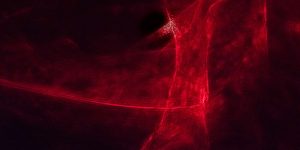
Silent songs
Katja Volk (DE)
Light is a matter of course for us. Its functionality in everyday life and technology makes it easy for us to overlook its simple beauty. Light is fascinating. Not only physically, but also visually. Silent songs uses light as a medium. Small, interactive light boxes create a sensual moment in which the viewer can concentrate on the light. This draws pictures in its very own way.
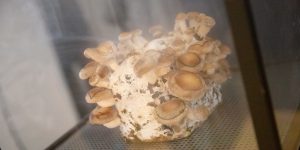
Growing Geometries – tattooing mushrooms
Theresa Schubert (DE)
Growing Geometries – tattooing mushrooms explores the morphology of fungi and evolution of geometrical shapes on living and growing membranes.

Anti Conductor
Ryo Kishi (JP)
Anti Conductor embraces the beauty of struggles. In our society, individuals tend to go with the flow of their environment. It’s human nature because it’s easier to survive. But it’s also monotonous and boring. If no one tries to go against the flow, nothing is going to change. The image of an individual struggling in the flow is full of power and energy, even if their efforts might not pay off.
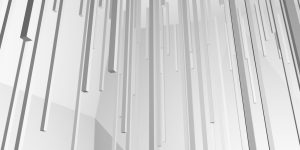
Luminescence
Benita Martis (DE)
In virtual reality (VR), light does not have to correspond with our reality. Physical laws can be overridden and redefined. This raises the question of how light looks, what effect it achieves and how it can be perceived in virtual reality. Can light in VR achieve a meditative effect? Can light take shape? Does light have the same meaning in virtual reality as in real reality? Luminescence is an experimental virtual experience which plays with forms, contrasts and biological feedback.
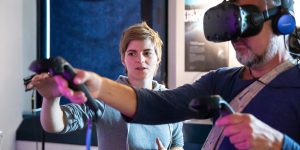
Tangible Universe
Annika Kreikenbohm (DE)
In the study of the universe, light is the one of the main sources of information accessible to us. Using satellites and telescopes, we collect the light of astronomical objects. First, each object appears as a single cloud of light. In the closer analysis of light, we recognize its nature and can distinguish stars from galaxies. In the virtual environment, numerical satellite data is translated into light sculptures and light is made tangible by haptic stimuli.

Presentation: Clinical Applications of Brain Computer Interface Systems
Brain-Computer Interfaces (BCIs) are new technologies that are becoming increasingly popular in medicine. Nowadays, computers and devices can be operated by measuring brain waves. Experience how this technology works and find out what research is currently working on. Erika Mondria, BCI expert at the Ars Electronica Center, will present the functionality of "recoveriX" and "mindBeagle" live.
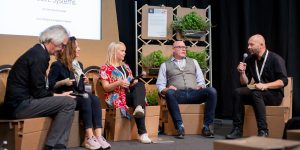
Poetic Systems
Panel Discussion
The panel discussion Poetic Systems looks at system-theoretical approaches at the nexus of art and architecture. Where can system theory, a sociological concept, be applied outside of its original discipline? Which dimensions are opened up by artistic research, an artistic viewpoint or Art Thinking in combination with system theory - and which new points of intersection emerge? Speakers with backgrounds in sociology, architecture, art and scientific research gather here to share their insights on this topic.
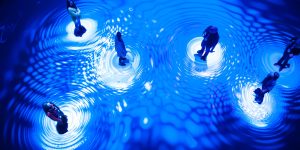
Quantum Logos
Mark Chavez (US), Ina Conradi (SG), Tate Chavez (US), Bianka Hofmann (DE), Bob Kastner (AU)
In an immersive reactive audio-visual experience, Quantum Logos uses cultural archetypes to explore natural phenomena focusing on the basics of quantum theory. We attempt to utilize aspects of intuitive, assumptive cultural models to describe the nature of existence as confirmed through scientific observation. The media artists Mark Chavez and Ina Conradi, sci-art producer and developer Bianka Hofmann and science communicator Bob Kastner form the collective Quantum Travelers
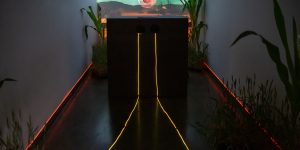
Navigating without a View
Maria Dada (UK), Yuan Yu Chen Feng (VE), Maria Bika (EL), Costas Kazantzis (EL), Greta Gandossi (IT), Ragnar Hrafnkelsson (IS), Fergus O’Connor (UK)
Navigating without a View is an immersive installation that investigates the possibilities of orientation in a world without a map or a compass, a world without representation and established views or truths. When guidance and direction become impossible everything falls back on the senses. But what becomes of the senses when they are altered by the digital, quantitative and mathematical?


